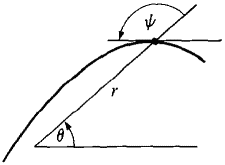| The ebook Elementary Calculus is based on material originally written by H.J. Keisler. For more information please read the copyright pages. |

|

Home  Trigonometric Functions Trigonometric Functions  Slopes And Curve Sketching in Polar Coordinates Slopes And Curve Sketching in Polar Coordinates  Theorem 2: Direction of a Curve Theorem 2: Direction of a Curve |
||||||||||






|
||||||||||
Theorem 2: Direction of a Curve
The following theorem gives a simple formula for tan ψ when r ≠ 0. THEOREM 2 Suppose r = f(θ) is a curve in polar coordinates and dr/dθ exists at a point P where r ≠ 0. Let L be the line tangent to the curve at P and let ψ be the angle between OP and L. Then
If dr/dθ ≠ 0,
Figure 7.8.4 DISCUSSION When r = Q, P is the origin so the line OP and angle ψ are undefined. The formula can be seen intuitively in Figure 7.8.4. Δθ is infinitesimal. As we move from the point P(r, θ) to the point Q(r + Δr, θ + Δθ) on the curve, the change in the direction perpendicular to OP will be very close to r Δθ, so we have
We shall postpone the proof to the end of this section. We can use Theorem 2 in curve sketching as follows.
Each of these cases is shown in Figure 7.8.5.
|
||||||||||
Home  Trigonometric Functions Trigonometric Functions  Slopes And Curve Sketching in Polar Coordinates Slopes And Curve Sketching in Polar Coordinates  Theorem 2: Direction of a Curve Theorem 2: Direction of a Curve |
||||||||||
Last Update: 2006-11-05









